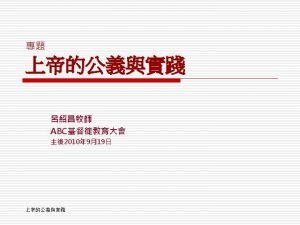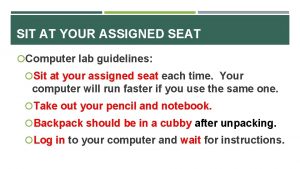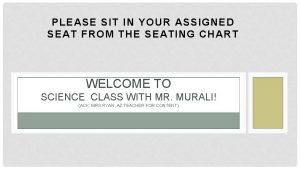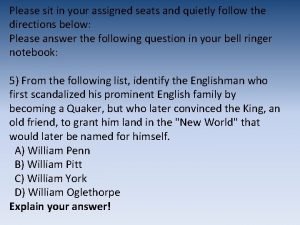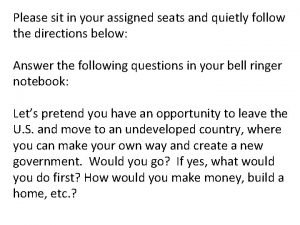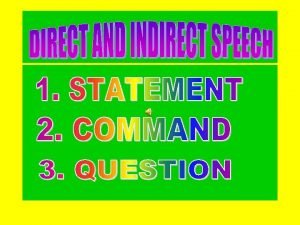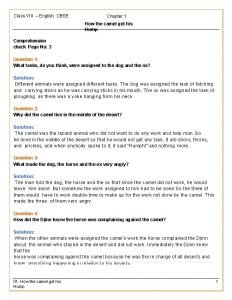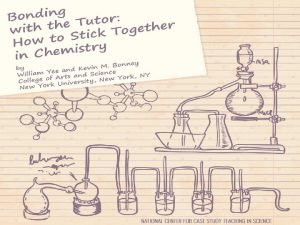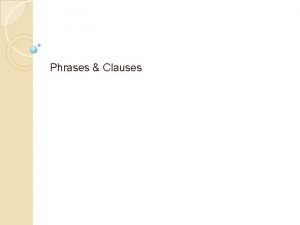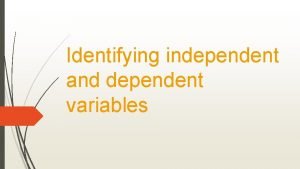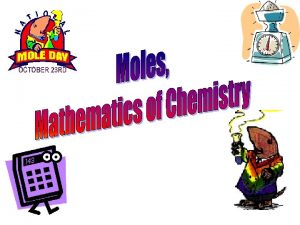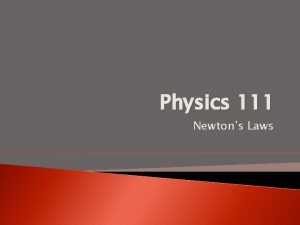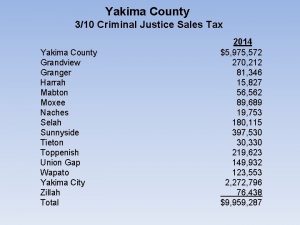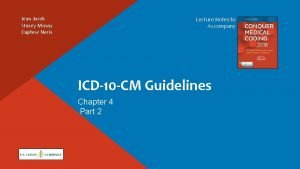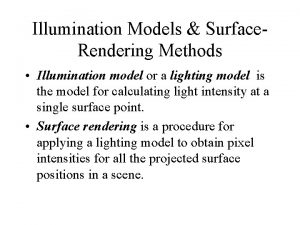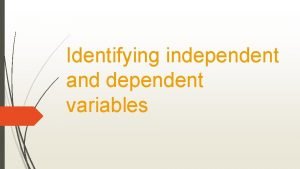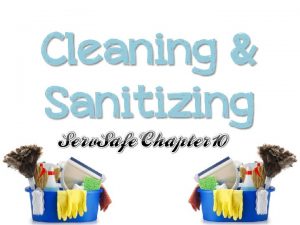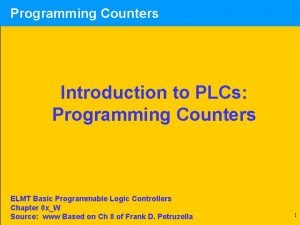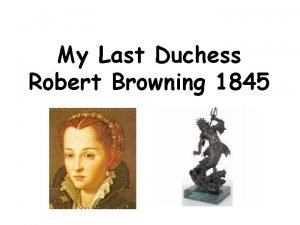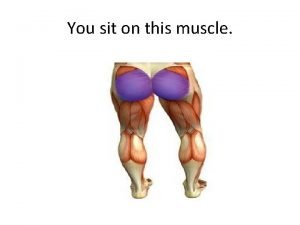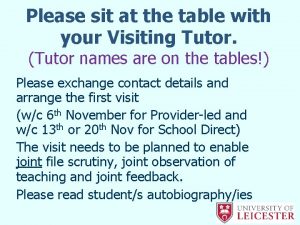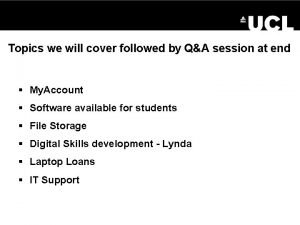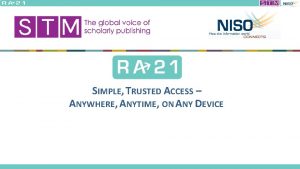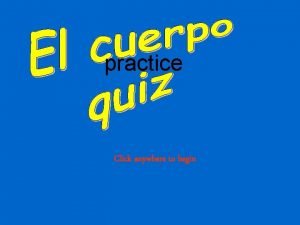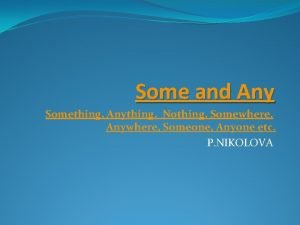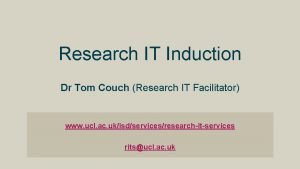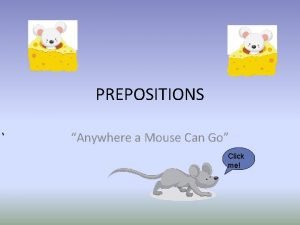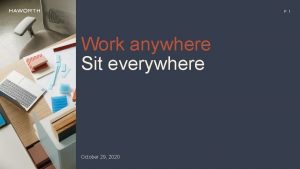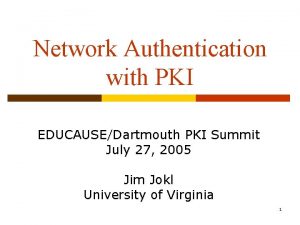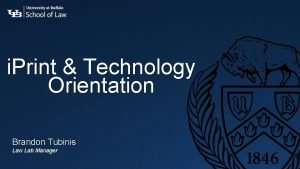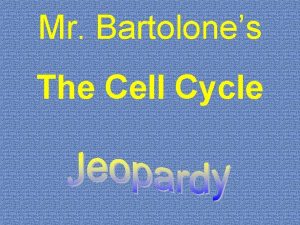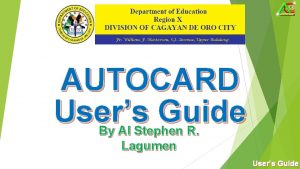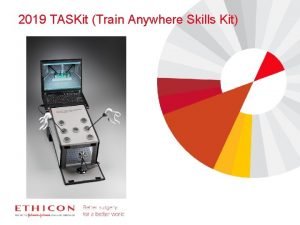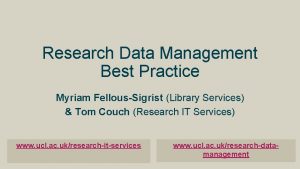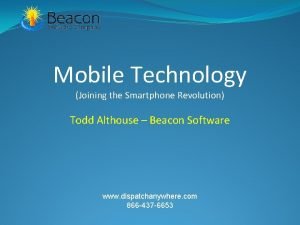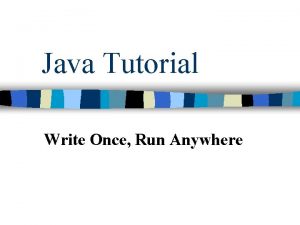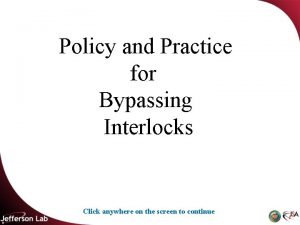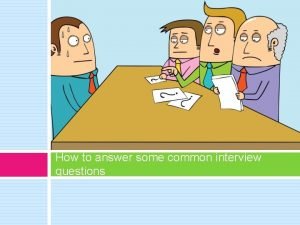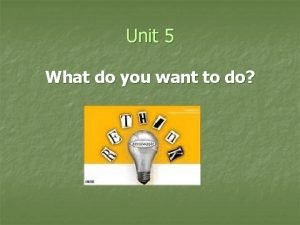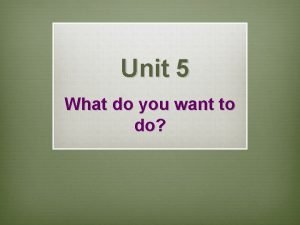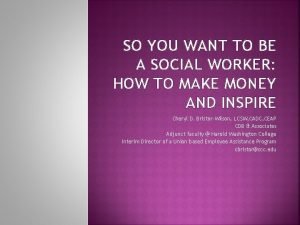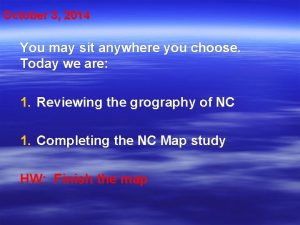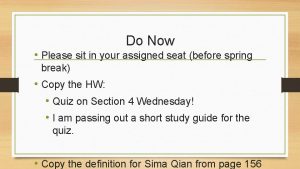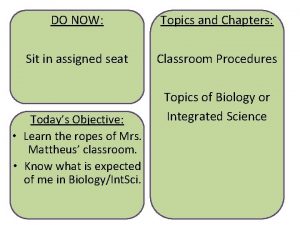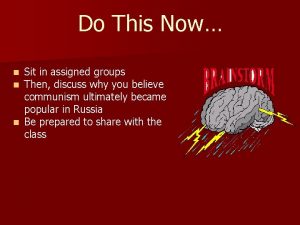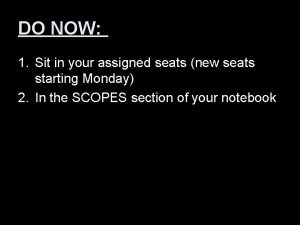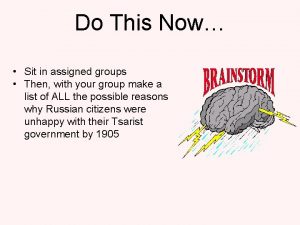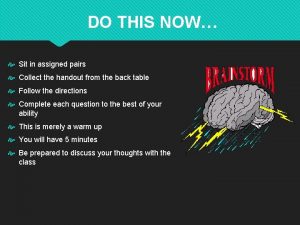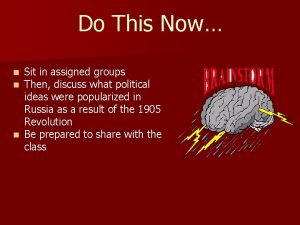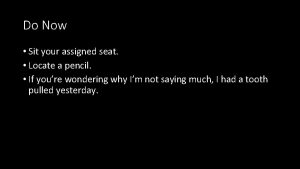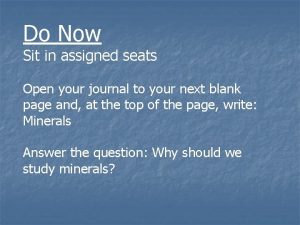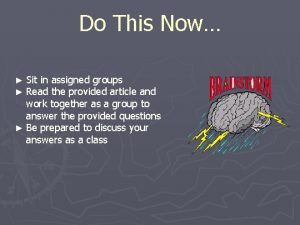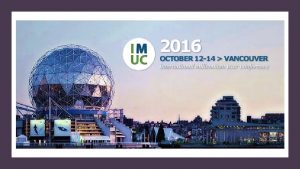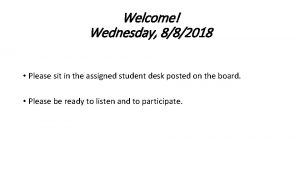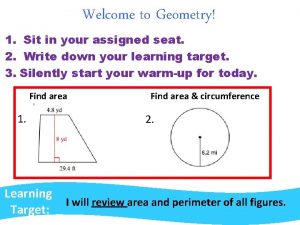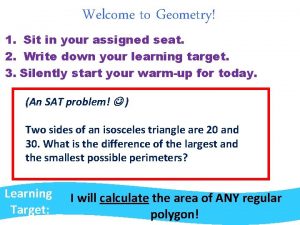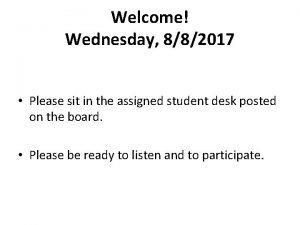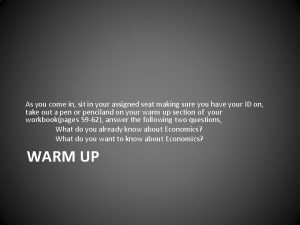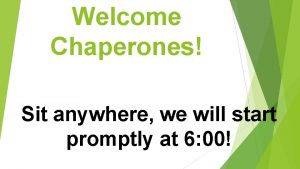WELCOME SIT ANYWHERE YOU WANT FOR NOW Assigned

































































- Slides: 65

WELCOME! SIT ANYWHERE YOU WANT (FOR NOW) (Assigned seats in a couple minutes…) On front of card First name Last name – your grade Class # (_APEH 06 -08__) Social Studies course you had in 9 th, teacher, final grade Social Studies course you had in 10 th, teacher, final grade First time AP ? Activities you’re involved with ex: Varsity Swim team Political Science Club YOU SHOULD HAVE SEVERAL THINGS HERE – IF NOT, FIX IT!

Wednesday, 9/4/19 AP European History – subject for the day Intro to course, exam, questions, me… Goals/activities • Introductions • Fill out 3 x 5 card (and return) • Discuss getting your book online • Show web page… http: //www. crsd. org/Page/7099 • Go through the syllabus Homework: 1. Get composition book (for journal) 2. Upload your online book to your home computer

Peruse Syllabus

Thursday, 9/5/19 AP Euro Hist – subject for the day Lesson #1 a - Renaissance Art Goals/activities 1. Journal #1 – look at the art on your desk. Describe the subject and the “attitude” it shows; discuss with your group members. 2. Join the AP Collegeboard online thingy MYAP. COLLEGEBOARD. ORG per. 02: Join Code: XK 9 JZY per. 03: Join Code: QR 3 Y 44 per. 06: Join Code: QGXZG 2 3. Art Packet and discussion Homework: Take notes on Lesson #1, Renaissance Art This is listed online as Lesson #3 (387 -393) http: //www. crsd. org/Page/7099

Friday, 9/6/19 AP Euro Hist – subject for the day Lesson #1 b - Renaissance Art Goals/activities 1. Homework check (Ren. Art) 2. Journal #2 – Describe how Renaissance art shows what educated people of the Renaissance cared about 3. Art Packet and discussion Homework: Take notes on Lesson #2, Italian Renaissance This is listed online as Lesson #1 (374 -378)


Monday, 9/9/19 AP Euro Hist – subject for the day Lesson #1 c - Renaissance Art Goals/activities 1. Homework check (Italian Renaissance) 2. Journal #3 – Choose two works of art to show a religious subject can be used to send a non-religious message 3. Art Packet and discussion Homework: Find the articles for Burke and Burkhardt Print them out, highlight/take notes in margin to show what each guy believed about the Renaissance

Tuesday, 9/10/19 AP Euro Hist – subject for the day Lesson #2 Italian Renaissance Goals/activities 1. Homework check (Burke vs. Burkhardt) 2. Journal #4 – Why is the Renaissance an appropriate start for this course? Why is it not? Provide evidence (B&B) 3. Italian Renaissance PPT Homework: For Wednesday: Interview your parents, or someone who remembers 9 -11. Do this on a separate paper. Write their thoughts down.

Wednesday, 9/11/19 AP European History – subject for the day 9 -11 Remembrance Day Goals/Activities 1. Homework check (interview with parents) 2. Journal #5: (free write) In what way did USA turn the tragedy of the attack on 9 -11 into victory? or: What’s YOUR impression of this tragic day? What emotions do you feel when talking to people who remember this vividly…? 3. Activity: • • Brief video from History Channel Discuss parent’s response Field Trip to memorial Follow up with the world response Homework: Take notes on Lesson #3, Humanism (378 -387) First quiz is on Friday (words from vocab, questions from notes)

Thursday, 9/12/19 AP Euro Hist – subject for the day Lesson #3 Italian Humanism Music of Mid Ages Goals/activities 1. Homework check (Lesson #3 – Italian Humanism) 2. Journal #6: answer the three questions at the top of the PSD (Primary Source Doc) Michelangelo and Pope Julius II 3. Italian Humanim PPT Homework: Read/notes Lesson #4: Northern Renaissance (397 -402) Don’t forget Quiz on lessons 1 -3



Pico Della Mirandola’s IMAGE OF MAN 1. What are the limits of mankind, according to Mirandola? 2. What is Mirandola suggesting about humans? 3. In reference to scholasticism in last night’s homework, how is this view so very different than scholasticism? 4. If the Renaissance is a rebirth, what will humans have the power to do in the coming years? Give any example you can think of to support this.

This leads us to the question that is in dispute: whether it be better to be loved than feared or feared than loved? One should want to be both loved and feared, but, because it is difficult to both at the same time, is much safer to be feared than loved, when, of the two, you have to choose. Niccolo Machiavelli, The Prince, 16 th century 1. Should a leader be feared or loved, according to Machiavelli? 2. If this quote is the basis for what is Machiavellian, what does that word mean? 3. Give an example of a Machiavellian leader, and describe how he’s Machiavellian.

Friday, 9/13/19 AP Euro Hist – subject for the day Lesson #4 Northern Humanism Music of Mid Ages Goals/activities 1. Quiz first 2. Homework check (Lesson #4 – Northern Ren. ) 3. Journal #7: Compare the writings of Machiavelli and Erasmus. Which would be the more effective ruler? Why? (provide evidence) 4. Hand in summer packet – back counter (name on it) 5. Northern Humanim PPT Homework: Read/notes Lesson #5 a: Exploration (448 -461)


Monday, 9/16/19 AP Euro Hist – subject for the day Lesson #5 a Exploration Goals/activities 1. Finish missing PPT from lessons 3 and 4 2. Homework check (Lesson #5 a Exploration) 3. Journal #8: Explain what gave the Europeans the advantage over other regions of the world, the ability to find them, and to later colonize them. Give examples. 4. Hand in summer packet (if you didn’t already) – back counter (name on it) 5. Finish lesson on European monarchies 6. Lesson on Exploration PPT Homework: Read/notes Lesson #5 b: Colonization (461 -472) – for Wednesday

Tuesday, 9/17/19 Jacoby’s History classes – subject for the day Constitution Day Goals/activities 1. No HW check 2. Journal #9: What is the purpose of our constitution. If don’t know, refer to the Preamble. Put in your own words! 3. Quick discussion on what our government looks like. 4. Group activity and discussion Homework: Read/notes Lesson #5 b: Colonization (461 -472) – for

Wednesday, 9/18/19 AP Euro Hist – subject for the day Lesson #5 b Colonization Goals/activities 1. Start with quick discussion of impact of eliminated an amendment (your homework) 2. Homework check (Lesson #5 b Colonization) 3. Journal #10: Refer to the 5 a notes and your 5 b notes from the John Green Crash Course video, explain why we should give credit to the Chinese for the real experts in navigation. Use names and examples. Compare to Europeans. 4. Lesson on Colonization PPT Homework: Read/notes Lesson #6: German Reformation (408 -419)

Thursday, 9/19/19 AP European History – subject for the day Lesson #5 – German Reformation Goals/activities 1. Homework check (Lesson #6 – German Ref. ) 2. Chart #1 (in place of Journal): 3. PPT on Lesson #5 Homework: Vocab quiz tomorrow on lessons 4 -6 Read/notes Lesson #7: English Ref. (422 -425) (due Monday)

Friday, 9/20/19 AP European History – subject for the day Lesson #6 a – The Tudors Goals/activities 1. Homework check (English Ref. ) will be Monday 2. QUIZ FIRST 3. PPT on Tudors Homework: Read/notes Lesson #7: English Ref. (422 -425) (due Monday) (HEADS UP: you’re getting a take-home essay assigned Monday)


Monday, 9/23/19 AP European History – subject for the day English Reformation Renaissance Luncheon preparation Take Home Essay Assignment Luncheon Dates 02 – Thurs 9/26 (this Thurs) 03 – Wed 10/2 (same day as essay) 06 -08 – Thurs 10/3 Goals/activities 1. Check HW and Chart #1 // FILL IN CHART #2 2. Each person in each group pics a person to “be” (show slides) 1. You’ll make food from his country (or region to which he has a connection – you may be creative) 2. You’ll write two paragraphs on him: What he did and why he matters 3. Both food and informal essay are due on the day of your luncheon 3. Assign take home essay (Due for everyone on Wed Oct. 2) 4. PPT #6 – English Reformation 5. Map practice; intro to the SHORT ANSWER Homework: Notes on Lesson #8 – Politics in Religion (419 -422, 425 -433)

What can we deduce from this map? What region of Europe will likely be a “hot bed” of religious conflict? Why?

Tues, 9/24/19 AP European History – subj for the day Catholic Counter Reformation Renaissance Luncheon reminders Take Home Essay hints (next slides) Luncheon Dates 02 – Thurs 9/26 (this Thurs) 03 – Wed 10/2 (same day as essay) 06 -08 – Thurs 10/3 Plans for each class Thurs 9/26 (02 Luncheon, 03 Review, 06 Luther) Wed 10/2 (02 Luther, 03 Luncheon, 06 Review) Thurs 10/3 (02 Review, 03, Luther, 06 Luncheon) Goals/activities 1. Check Chart #2 // Fill in Chart #3 2. Short Answer Practice 1. As a group, come up with at least three possibilities for ea 2. THEN, choose one to write about; be sure to include both evidence and analysis – we’ll look at student samples. 3. Discussion on take home essay (Due for everyone on Wed Oct. 2) 4. PPT #7 – Catholic Counter Reformation Homework: Notes on Lesson #9 – Wars of Religion (433 -437) Per. 02 – plan to eat lunch here in class Thursday

Essay preparation and practice

Thesis • Examples of a good thesis develop an argument, but not really repeating the question. This is NOT natural or easy. • Full 10 points ONLY for thesis and opening paragraphs which create an argument which hits all parts of question, but to NOT just answer question • It should also provide a clear and eloquent introduction to this era • What’s a good example?

Possible thesis examples: Compare and contrast the motives and actions of Martin Luther in the German states and King Henry VIII in England in bringing about religious change during the Reformation. (2005 -4) 1. Luther and Henry had similarities and differences. They both led new religions, but neither meant to do that. 2. A very religious man, Luther’s motives for the religious change he caused were based on changes he expected the Church to make, while Henry’s were based on fulfilling his role as king by providing stability by avoiding civil war. While their actions did lead to conflict, neither intended to do so. Henry’s actions were not religious, but rather to take financial advantage of his new position as head of the Anglican Church, while Luther’s remained loyal to commitment for religious change.

Contextualization • Describes a broader historical context relevant to the prompt. • The response must relate the topic of the prompt to broader historical events, developments, or processes that occur before, during, and/or continue after the time frame of the question. CANNOT BE JUST A PHRASE OR REFERENCE. • Describe why Henry pushed so hard for sons, based on things like who he was, as the son of Henry VII and brother of Arthur, and his duty as king. • Describe also how the Church had become corrupt, and how Luther loathed this, maybe why Tetzel (and Albert of Mainz) were raising $$, and the impact of things like the Golden Bull and Printing Press.

Evidence • Provides specific examples of evidence relevant to the topic of the prompt; includes and focuses on most relevant examples • Uses evidence to clearly support argument. Evidence is explained deeply, fitting into a larger picture; demonstrated clear understanding of importance of evidence.

Analysis • Uses historical reasoning (comparison, causation, Change over time) to frame or structure an argument that addresses the prompt • Demonstrates a complex understanding of historical development. Argument was clearly proven, eloquently discussed, and discussion remained deep and never superficial.

Wednesday, 9/25/19 AP European History – subject for the day Luncheon Dates Wars of Religion 02 – Thurs 9/26 (this Thurs) Countdown to Scantron (Fri Oct 4) 03 – Wed 10/2 (same day as essay) 06 -08 – Thurs 10/3 Goals/activities 1. Check Chart #3 / Journal #11 (Bruegel painting analysis) 2. Each person in each group pics a person to “be” 1. You’ll make food from his country (or region to which he has a connection – you may be creative) 2. You’ll write two paragraphs on him: What he did and why he matters 3. Both food and informal essay are due on the day of your luncheon Plans for each class 4. PPT #7 – Catholic Counter Ref Homework: Thurs 9/26 (02 Luncheon, 03 Review, 06 Luther) Wed 10/2 (02 Luther, 03 Luncheon, 06 Review) Thurs 10/3 (02 Review, 03, Luther, 06 Luncheon) Quiz tomorrow (Lessons 7 -9) Per. 02: Luncheon (food and short essay) (after quiz) Take Home Essay (Luther/Henry) due Wed 10/2 (the day we get back)

Pieter Bruegel Painted scenes of common man doing common things in Germany

Pieter Bruegel Painted scenes of common man doing common things in Germany

Pieter Bruegel Painted scenes of common man doing common things in Germany

Pieter Brugel Painted scenes of common man doing common things in Germany

Brughel Peasants’ Wedding Pieter Brugel 18 Painted scenes of common man doing common things in Germany This is Brughel’s most famous.


Journal Question #11: Answer in full sentences. Provide evidence. Analyze the evidence. Describe the typical subject of Breughel's work. Show this is a change from Medieval and High Renaissance works of art

G 1 a - Notice: The celebration of the common man, doing common things There’s nothing religious Describe the typical subject of Breughel's Natural behavior work. Show this is a change from Non-elite Medieval and High Renaissance works of art Realistic, and slightly perspective This is your Warm Up today. Part #1 (next slide is part #2)

Journal Question #12: Answer in full sentences. Provide evidence. Analyze the evidence. a. Analyze two features of European leisure activities, based on Breughel's style of painting. Use this work as your prompt. b. Describe how religion still played a role in the lives of most Europeans, even after the Reformation began.

G 1 b - Notice: Leisure Activities are communal Very participatory Seem busy, very busy and active Still tied to Church calendar, but Closely tied to harvests* Seem like all types of people Common man doing wild things a. Analyze two features of European leisure activities, based on Breughel's style of painting. Use this work as your prompt. b. Describe how religion still played a role in the lives of most Europeans, even after the Reformation began.

Thursday, 9/26/19 AP European History – subject for the day 02 – Renaissance Luncheon 03 – Review Day Plans for each class 04 – Movie: Luther Thurs 9/26 (02 Luncheon, 03 Review, 06 Luther) Wed 10/2 (02 Luther, 03 Luncheon, 06 Review) Thurs 10/3 (02 Review, 03, Luther, 06 Luncheon) Goals/activities 1. Quiz First 2. Then, your class activity Homework: Friday is a documentary on the Tudors Scantron is next Friday, Oct 4

Friday, 9/27/19 AP European History – subject for the day Movie: Henry VIII Goals/activities Use worksheet to follow the documentary. Homework: Plans for each class Thurs 9/26 (02 Luncheon, 03 Review, 06 Luther) Wed 10/2 (02 Luther, 03 Luncheon, 06 Review) Thurs 10/3 (02 Review, 03, Luther, 06 Luncheon)


Review Day POD – AP European History Test Prep (review) day! 1. Finish Tudor PPT 2. Quick look at three video reviews (next slide) 3. Look for blanks and confusion in notes 4. Discuss any confusing vocab words 5. Go over some sample questions (next slides) 6. A last look at notes, lesson by lesson 7. STARBUCKS STUDY SESSION – Thurs 10/3 @ 5: 00 -6: 00 Scantron is Friday Oct 4 Bluebook (short answer test) is Tue Oct 8 Journals due same day as Bluebook

Short Answer practice Historians have sometimes referred to the Renaissance era as the start of a modern history. 1. Provide TWO pieces of evidence to support this characterization of this period and explain how they support it. 2. Provide ONE specific piece of evidence that undermines this characterization of this time period, and explain how it undermines it.

Renaissance wrap-up 5 m 11 m Renaissance 12 m Reformation

Sample Test Questions SAMPLE ART QUESTION 1. An expert in realism, Leonardo used a technique in his Mona Lisa to show perspective. What do we call this subtle use of shading to show depth? a. single point perspective b. leading lines. c. fresco d. chiaroscuro

Sample Test Questions SAMPLE QUESTION in the NEW FORMAT 2. Michelango’s David displays which of the following thematic innovation of Renaissance artists? a. The depiction of religious personages b. Accurate human anatomy c. The use of bronze as a material d. The portrayal large groups of statues to frighten the crowd

Sample Test Questions SAMPLE QUESTION 3. At last it seems to be that I have come to understand why man is the most fortunate of all creatures and consequently worthy of all admiration…. The nature of all other beings is limited…. Imagine! The great generosity of God! The happiness of man! To man it is allowed to be whatever he chooses to be! Pico della Mirandola, Oration on the Dignity of Man, 1486 From the passage, one may infer that Pico believed that humankind was unique because a. human beings have a soul b. human beings know that they will die c. it is possible for human beings to go to heaven d. the potential of the human being is unlimited

Sample Question Refer to the following passage for the next three questions [Considering the origin of] grace, I find one universal rule concerning it, which seems to me worth more in this matter than any other in all things human that are done or said: and that is to avoid affectation to the uttermost and as it were a very sharp and dangerous rock; and, to use possibly a new word, to practice in everything a certain nonchalance [sprezzatura] that shall conceal design and show that what is done and said is done without effort and almost without thought. From this I believe grace is in large measure derived, because everyone knows the difficulty of those things that are rare and done well, and therefore facility in them excites the highest admiration. [And] I wish to discuss another matter, which I deem of great importance and therefore think our Courtier ought by no means to omit: and this is to know how to draw and to have acquaintance with the very art of painting…. And truly he who does not esteem this at, seems to me very unreasonable; … [For] the ancients greatly prized both the art and the artists, which thus attained the summit of highest excellence; very sure proof of which may be found in the antique marble and bronze statues that yet are seen…. . Baldesar Castiglione, The Book of the Courtier, 1508 -1513 4. The passage is indicative of the “princely ideal” of the late Renaissance, because a. b. c. d. it promotes individual achievement it is by the author of The Prince it describes the manner in which a prince should behave it focuses on the value of personal achievement for individual success rather than the civic good

Sample Question Refer to the following passage for the next three questions [Considering the origin of] grace, I find one universal rule concerning it, which seems to me worth more in this matter than any other in all things human that are done or said: and that is to avoid affectation to the uttermost and as it were a very sharp and dangerous rock; and, to use possibly a new word, to practice in everything a certain nonchalance [sprezzatura] that shall conceal design and show that what is done and said is done without effort and almost without thought. From this I believe grace is in large measure derived, because everyone knows the difficulty of those things that are rare and done well, and therefore facility in them excites the highest admiration. [And] I wish to discuss another matter, which I deem of great importance and therefore think our Courtier ought by no means to omit: and this is to know how to draw and to have acquaintance with the very art of painting…. And truly he who does not esteem this at, seems to me very unreasonable; … [For] the ancients greatly prized both the art and the artists, which thus attained the summit of highest excellence; very sure proof of which may be found in the antique marble and bronze statues that yet are seen…. . Baldesar Castiglione, The Book of the Courtier, 1508 -1513 5. The passage can be said to illustrate the transformation of traditional values into Renaissance values, because a. b. c. d. it stresses the pursuit of excellence it extols the virtue of skill in the visceral arts (intellectual) rather than the martial arts (fighting) it stresses the changing of social status of the artist it values grace

Sample Question Refer to the following passage for the next three questions [Considering the origin of] grace, I find one universal rule concerning it, which seems to me worth more in this matter than any other in all things human that are done or said: and that is to avoid affectation to the uttermost and as it were a very sharp and dangerous rock; and, to use possibly a new word, to practice in everything a certain nonchalance [sprezzatura] that shall conceal design and show that what is done and said is done without effort and almost without thought. From this I believe grace is in large measure derived, because everyone knows the difficulty of those things that are rare and done well, and therefore facility in them excites the highest admiration. [And] I wish to discuss another matter, which I deem of great importance and therefore think our Courtier ought by no means to omit: and this is to know how to draw and to have acquaintance with the very art of painting…. And truly he who does not esteem this at, seems to me very unreasonable; … [For] the ancients greatly prized both the art and the artists, which thus attained the summit of highest excellence; very sure proof of which may be found in the antique marble and bronze statues that yet are seen…. . Baldesar Castiglione, The Book of the Courtier, 1508 -1513 6. The passage illustrates the values of Renaissance humanism, because a. b. c. d. it instructs the individual to pay attention to personal appearance it argues that reason should be the measure of all things it looks to the ancients for guidance in matters of taste and accomplishment it encourages all men to aspire to be Courtiers

Short answer practice (to be discussed right before test on Friday) a. Briefly explain one impact of the Protestant Reformation on Education. b. Briefly explain one impact of the Protestant Reformation on the family. c. Briefly explain one impact of the Protestant Reformation on women 1. Brainstorm several possibilities 2. Choose one, include the example (evidence) you’ll use to prove your point. 3. Introduce it, then include analysis or explanation to prove it to be true.

Monday, 9/30/19 AP European History – subject for the day NO SCHOOL

Tuesday, 10/1/19 AP European History – subject for the day NO SCHOOL

Friday, 10/4/19 POD TEST DAY BE LU ST TO CK OF DA DIRECTIONS Y! 1. Sit anywhere 2. grab a scantron (front of room) 3. Cell phone out and OFF 4. Put phone on counter or chalk rack 5. On scantron: name, Subject (REN), Period: 02 or 03 or 06 5. Put name on test questions, too REMINDER #1: BLUEBOOK IS Tuesday REMINDER #2: JOURNALS COLLECTED FRIDAY


The Pope Gargoyle counting $$ Certificates being sold to commoners 13 a 13 b 15 c 9 d

Monday, 10/7/19 Argue Day 1. Put all pencils and blue/green/pink highlighters away (02 = blue // 03 = green // 04 -05 = pink) 2. Look for scantron errors as soon as you get your test 3. We’ll go page by page, section by section. 4. If you have a question you think could have been another answer, raise your hand 5. If your argument makes sense to me, I could give everyone the point back 6. If #5 is the case, circle/highlight the question #, raise your hand, and spin the test so it faces me; point to it when I arrive – you’ll get a “ happy highlighter” mark 7. Once there is only 5 min left in class, argue day is over ESSAYS ARE ALWAYS IN PEN; BRING TWO PENS TOMORROW

Tuesday, 10/8/19 Short Answer Day 1. Take out your journal – DUE TODAY 2. USE PEN ONLY 3. Brainstorm first, then, for each part, be sure to: 1. Introduce your evidence in a full sentence 2. Analyze reasoning, like show why it matters 4. All writing must be on lined sheet, and must stay within the block 5. Plan carefully. a. Each question has three parts b. Five points for each part – 30 points total

Short answer practice (to be discussed right before test on Friday) a. Briefly explain one impact of the Protestant Reformation on Education. b. Briefly explain one impact of the Protestant Reformation on the family. c. Briefly explain one impact of the Protestant Reformation on women 1. Brainstorm several possibilities 2. Choose one, include the example (evidence) you’ll use to prove your point. 3. Introduce it, then include analysis or explanation to prove it to be true.

Short answer practice (to be discussed right before test on Friday) a. Briefly explain one impact of the Protestant Reformation on Education. a. b. c. d. e. More printing presses and printing centers appeared, pumping out more books and mass literature of all kinds. This is because of the new demand for Bibles for everyone, since the Reformation encouraged all people to read the Bible on their own, leading to the production of more Bibles and a need for more printing centers. More people were educated because of the Printing Press, which was needed to print up Bibles. This invention caused more books to be printed, leading to more people educated. Man now saw himself as more limitless because of the impact of humanism. Humanism has been embraced by the Protestants, replacing Scholasticism. Humanism spoke of man seeing himself as limitless, leading to an explosion of study. New areas of study appeared, since now the Church universities now had competition. Humanist schools appeared around Europe, allowing for education OTHER than that run by the Church run universities worked harder to properly educate their students, since they now had competition. This led to better teaching and better learning.

 Mercy bears richer fruits than strict justice
Mercy bears richer fruits than strict justice Metaphasepdm
Metaphasepdm Sit in your assigned seat
Sit in your assigned seat Sit in your assigned seat
Sit in your assigned seat Sit in your assigned seat
Sit in your assigned seat Sit in your assigned seat
Sit in your assigned seat Try your best study my father said to me
Try your best study my father said to me Greensboro sit ins
Greensboro sit ins Now i see it now you don't
Now i see it now you don't Describe how dog horse and ox turned against the man
Describe how dog horse and ox turned against the man Hnhh polar or nonpolar
Hnhh polar or nonpolar You may sit wherever you like
You may sit wherever you like Elements of spoken word poetry
Elements of spoken word poetry Hello dear warm greetings how are you doing ?
Hello dear warm greetings how are you doing ? Identifying dependent and independent variables
Identifying dependent and independent variables Each element has an assigned
Each element has an assigned Newtons laws
Newtons laws It's friday night and skyler has been assigned
It's friday night and skyler has been assigned Yakima sales tax
Yakima sales tax Which of the following is true about comments in pl/sql mcq
Which of the following is true about comments in pl/sql mcq Poa indicators are assigned in the inpatient setting for
Poa indicators are assigned in the inpatient setting for Illumination model
Illumination model What is the dependent variable
What is the dependent variable A food handler was assigned to clean a slicer
A food handler was assigned to clean a slicer Maintain your assigned protective mask
Maintain your assigned protective mask Assigned address
Assigned address Hollila
Hollila Strangers like you that pictured countenance
Strangers like you that pictured countenance What is this
What is this Visiting tutor
Visiting tutor Wise men three clever are we
Wise men three clever are we Onedrive ucl
Onedrive ucl Anytime anywhere any device
Anytime anywhere any device Anytime anywhere any device
Anytime anywhere any device Click anywhere to continue
Click anywhere to continue Goanywheremft
Goanywheremft How to access tally from remote
How to access tally from remote Any something
Any something Desktop ucl anywhere
Desktop ucl anywhere Preposition anywhere a mouse can go
Preposition anywhere a mouse can go Sitting anywhere at work
Sitting anywhere at work Dartmouth vpn
Dartmouth vpn Iprint anywhere ub
Iprint anywhere ub Maximo upgrade
Maximo upgrade Anywhere
Anywhere Click anywhere to start
Click anywhere to start Autocard anywhere
Autocard anywhere Train anywhere
Train anywhere Targit anywhere
Targit anywhere Desktop @ucl
Desktop @ucl Maximo anywhere roadmap
Maximo anywhere roadmap Click anywhere to start
Click anywhere to start Dispatch anywhere mobile
Dispatch anywhere mobile Java write once run anywhere
Java write once run anywhere Building
Building Click anywhere to start
Click anywhere to start Connection_dropped_list_full
Connection_dropped_list_full Click anywhere to start
Click anywhere to start How is a struck-by rolling object defined?
How is a struck-by rolling object defined? What your name reported speech
What your name reported speech Lirik lagu more more more we praise you
Lirik lagu more more more we praise you More more more i want more more more more we praise you
More more more i want more more more more we praise you Why do you want to work for us
Why do you want to work for us Unit 5 grammar future time answers
Unit 5 grammar future time answers Go con ing
Go con ing So you want to be a social worker
So you want to be a social worker
